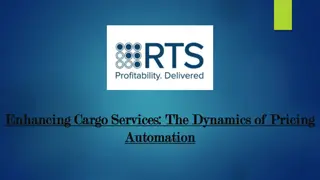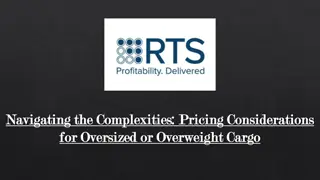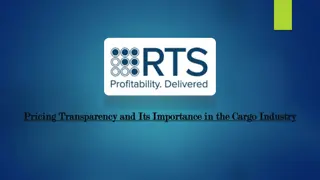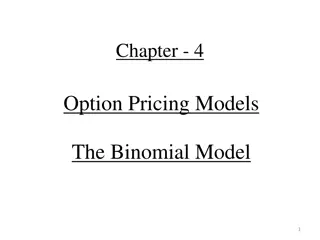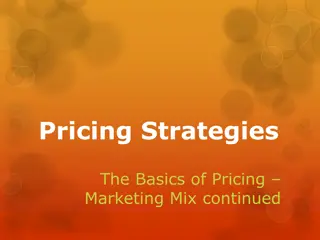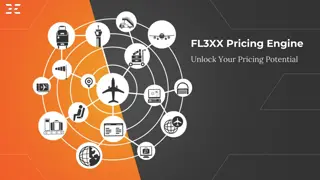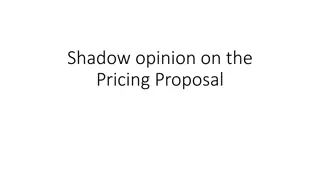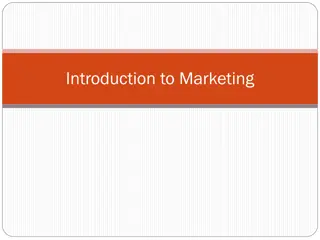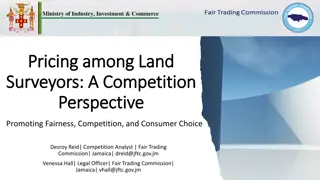Understanding the Concept and Importance of Pricing in Marketing
Dr. Anubha Gupta, a faculty member at Vikram University, delves into the essential role of pricing in marketing strategies. Exploring the concept, objectives, and influencing factors of pricing decisions, this content emphasizes the significance of pricing in achieving business goals and competitive edge.
Download Presentation

Please find below an Image/Link to download the presentation.
The content on the website is provided AS IS for your information and personal use only. It may not be sold, licensed, or shared on other websites without obtaining consent from the author. Download presentation by click this link. If you encounter any issues during the download, it is possible that the publisher has removed the file from their server.
E N D
Presentation Transcript
Dr.Anubha Gupta Faculty , S.S. in Commerce Vikram University Useful for BBA(H)/B.COM(H)/M.COM and allied subject
Concept of Pricing Price is one of the most important variable in the marketing mix pricing respond quantity as money which can received by manufactures on behalf of good and services provided to consumer , for manufactures it is income but for consumer it is expenses.
Concept of pricing From seller s point Quantity of money received by the seller From buyer s point Quantity of goods or services received by the buyer
Objective of price Return on investment Profit maximizing Profit related Market share Maximize sales Sales related Remove competitors Achieve leadership by pricing To face competition Competition related
Importance of price It is importance function of marketing management Measure & comparison of value Effect on sales promotion measure Control of economic progress Effect on marketing programme Criteria of evaluation
Importance of price Situations when pricing decisions assume more importance : 1.When the company determines price for the first time 2.When the situation compel a company to initiate price change 3.When the price change is initiated by competitor 4.When the cost and demand of product is closely interrelated
Factor influencing pricing decisions Internal factorObject of firm Return on investment External factorDemand Role of top management suppliers Consumers Marketing mix Competition Cost of product Exchange rate Product differentiation Govt. policy
Types of price policies on flexibility basis Types of price policies On geographical basis On price level basis On Specialty basis
Types of price policies (A) flexibility basis: 1.one price policy 2.flexible price policy
Types of price policies (B)Price level basis: 1.competition & meeting policy 2.under or above the market price policy
Types of price policies (C) specialty basis: 1.bait pricing policy 2.price line policy 3.full product line price policy 4.skimming price policy 5.follow the leader price policy 6.market penetration price policy 7.loss leader pricing policy 8.unit pricing policy 9.psychological pricing policy
Types of price policies (D) geographical basis: 1.Factory price policy 2.Freight absorption pricing policy 3.Zonal delivery pricing policy 4.Uniform delivery pricing policy
Pricing strategies Cost + Pricing : Useful for manufacturers, wholesalers and retailers. Under it, management works out the cost of goods manufactured or purchased for resale and adds a percentage of profits to it to determine the selling price.
Pricing strategies Below Cost Pricing: Useful for obsolete goods It is sometimes desirable to sell the goods at a price less than the cost. This method is used to sell perishable goods to save the firm from excessive losses due to deterioration in quality with the passage of time.
Pricing strategies Competition-Oriented Pricing: Useful for manufacturers when: The market is highly competitive, The product of one manufacturer is not significantly differentiated from those of others. As such, under competition-oriented pricing strategy, same price is fixed by all competitive producers.
Pricing strategies Follow the Leader Pricing: Under this policy, one firm i.e. the price leader with dominant market share sets the price; and other firms in the industry follow that price. Followers match price cuts or price rises, as initiated by the leader. Some firms, however, may match price cuts but not price rises initiated by the leader; when recessionary conditions prevail in the market. Or some firms may match price rise but not price-cuts initiated by the leader; when boom conditions prevail in the market.
Pricing strategies Penetration Pricing: Useful for manufacturers for introducing a new product by them. A manufacturer sets a low price for his product; so as to penetrate into a new market for popularizing his product; and capture a large market share over a period of time, by establishing goodwill as low-price seller .
Pricing strategies Skimming the Cream Pricing: It is useful for specialty products; i.e. luxurious items in which case rich consumers may not mind paying high prices due to their ego, status, or prestige. It is just opposite to penetration pricing. Under this strategy, a manufacturer sets a very high initial price for his product; as so to make maximum profits. It is useful under conditions of rapidly advancing competition; so that by the time, competitors gain ground, the particular manufacturer in question can withdraw from the market or reduce price suitably-having already made much profits.
Pricing strategies Discriminating Pricing: It is useful for professional services e.g. CA ,doctor s or lawyer s; who may charge different fee from different customers, on the basis of their ability to pay. It is possible when customers are separated from each other, on the basis of their (market) location. For example, such kind of price discrimination is found in case of seating in cinema halls, in railway services etc.
Pricing strategies Loss-Leader Pricing: It is useful for retailers. They sharply cut prices on one or few popular items (even below its cost) to attract customers. The items on which prices are cut are called loss leaders. Having attracted in this way; they may charge very high prices for some of their other products; which consumers may pay thinking that the price is just reasonable. In fact under this pricing strategy, loss suffered in case of loss-leader-product ; is compensated through higher prices charged for other products.
Pricing strategies Keep Out Pricing: It can be adopted only by big firms who have large resources at their command. It is a pre-emotive pricing policy involving fixation of low prices to discourage or prevent the entry of new firms into the industry.
Pricing strategies Psychological Pricing: It is useful for retailers. Under psychological pricing strategy, price is so fixed that it appears to be somewhat lesser; and influences the mind of the buyer to buy the product. For example, a price fixed at Rs. 199 instead of straightway Rs. 200 is an instance of psychological pricing strategy.
Pricing strategies Differential Pricing for Product-Life-Cycle Stages: Under this pricing strategy, the manufacturer has different price policies in view of the product- life cycle stage a product is passing though. For example, a manufacturer may fix a low price when the product is in the introduction stage; may slightly raise the price during the growth stage; may stabilize the price at the saturation stage and may finally reduce the price when the product is passing through the declining stage.
Product price decision process Estimating the demand of product Selecting the pricing objectives Selecting the pricing objectives Estimating customer's expected price Determination of the market share Selecting price policy & strategy Estimating the competitive influence Selection of the specific price Estimates of sales at price
References: www. Yourarticlelibrary.com www.google.com
. Thank You






